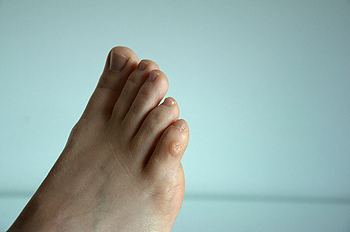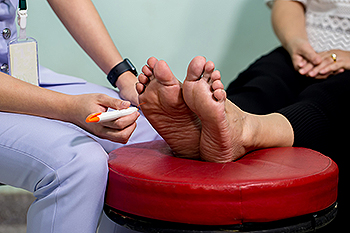Connect With Us
Blog

A tiny hairline crack in a bone is known as a stress fracture. It is caused by repetitive stress in the metatarsals, or long bones of the feet. It is common for athletes who do a lot of pounding on their feet, such as runners, basketball players, and tennis players. Among the causes or contributing factors to the development of stress fractures are shoes that do not provide ample cushioning, running or pounding on hard surfaces, tight muscles or tendons, and increasing the time or intensity of the particular activity. Stress fractures often go unnoticed at first, because the pain usually dissipates after stopping the activity. Also, stress fractures are difficult to detect, as they may not always show up on X-rays. The number one way to treat a stress fracture is to stop the activity. If you have further questions about stress fractures, please consult a podiatrist who can perform imaging tests to examine your feet and provide further treatment options.
Activities where too much pressure is put on the feet can cause stress fractures. To learn more, contact one of our podiatrists from Biebel & DeCotiis Podiatry Associates. Our doctors can provide the care you need to keep your pain free and on your feet.
Dealing with Stress Fractures of the Foot and Ankle
Stress fractures occur in the foot and ankle when muscles in these areas weaken from too much or too little use. The feet and ankles then lose support when walking or running from the impact of the ground. Since there is no protection, the bones receive the full impact of each step. Stress on the feet can cause cracks to form in the bones, thus creating stress fractures.
What Are Stress Fractures?
Stress fractures occur frequently in individuals whose daily activities cause great impact on the feet and ankles. Stress factors are most common among:
- Runners
- People affected with Osteoporosis
- Tennis or basketball players
- Gymnasts
- High impact workouts
Symptoms
Pain from the fractures occur in the area of the fractures and can be constant or intermittent. It will often cause sharp or dull pain with swelling and tenderness. Engaging in any kind of activity which involves high impact will aggravate pain.
If you have any questions please feel free to contact one of our offices located in Holmdel and Middletown, NJ . We offer the newest diagnostic and treatment technologies for all your foot and ankle needs.

Calluses and corns on the feet are both hardened areas of skin that form as the result of repeated pressure, friction, or rubbing. If you do a lot of walking or running, and especially while wearing shoes that are new or do not fit properly, at some point you are likely to develop a corn or callus. A corn is a hardened area that generally pushes deeper into the skin and can be painful. Three types are hard corns, soft corns, and seed corns. A hard corn is usually yellow and commonly forms on the top or side of a toe. It may contain a hardened kernel in the center, which can become painful when it is under pressure from a shoe. Soft corns are whitish in color and form between the toes. They stay soft because of the moisture that builds up in the feet. Seed corns are tiny bumps that form in clusters on the bottom of the foot, frequently on the ball of the foot or bottom of the heel. A callus is generally spread over a larger area and is not normally painful. They may form on the bottom of the foot, just behind the toes, where excessive walking puts pressure on the bones. Bone deformities may play a part in developing a callus. Painful or irritating corns and calluses can be pared away by a podiatrist, who can safely perform this procedure.
If you have any concerns regarding your feet and ankles, contact one of our podiatrists of Biebel & DeCotiis Podiatry Associates. Our doctors will treat your foot and ankle needs.
Corns: What Are They? and How Do You Get Rid of Them?
Corns can be described as areas of the skin that have thickened to the point of becoming painful or irritating. They are often layers and layers of the skin that have become dry and rough, and are normally smaller than calluses.
Ways to Prevent Corns
There are many ways to get rid of painful corns such as wearing:
- Well-fitting socks
- Comfortable shoes that are not tight around your foot
- Shoes that offer support
Treating Corns
Treatment of corns involves removing the dead skin that has built up in the specific area of the foot. Consult with Our doctors to determine the best treatment option for your case of corns.
If you have any questions please feel free to contact one of our offices located in Holmdel and Middletown, NJ . We offer the newest diagnostic and treatment technologies for all your foot and ankle needs.

Diabetics frequently end up with a condition known as peripheral neuropathy, which is a type of nerve damage that affects the toes and feet, as well as other extremities. Its most common symptom is shooting pain, along with tingling, burning, and numbness. Diabetic peripheral neuropathy can also affect balance and coordination, increasing the risk of falls. People who have had diabetes for 25 years or more and those who are unable to control their blood sugar levels are most susceptible to developing neuropathy. There is no known cure for this condition, but it can be treated. Managing blood sugar levels is the paramount treatment, followed by pain management with certain medications. Lifestyle changes, such as losing weight, ceasing alcohol intake, and stopping smoking are other effective ways to lessen the discomfort of diabetic neuropathy. Experts also recommend a daily exercise regime. If you are experiencing symptoms of diabetic peripheral neuropathy, please consult a podiatrist who can offer a treatment plan that is appropriate for you.
Neuropathy
Neuropathy can be a potentially serious condition, especially if it is left undiagnosed. If you have any concerns that you may be experiencing nerve loss in your feet, consult with one of our podiatrists from Biebel & DeCotiis Podiatry Associates. Our doctors will assess your condition and provide you with quality foot and ankle treatment for neuropathy.
What Is Neuropathy?
Neuropathy is a condition that leads to damage to the nerves in the body. Peripheral neuropathy, or neuropathy that affects your peripheral nervous system, usually occurs in the feet. Neuropathy can be triggered by a number of different causes. Such causes include diabetes, infections, cancers, disorders, and toxic substances.
Symptoms of Neuropathy Include:
- Numbness
- Sensation loss
- Prickling and tingling sensations
- Throbbing, freezing, burning pains
- Muscle weakness
Those with diabetes are at serious risk due to being unable to feel an ulcer on their feet. Diabetics usually also suffer from poor blood circulation. This can lead to the wound not healing, infections occurring, and the limb may have to be amputated.
Treatment
To treat neuropathy in the foot, podiatrists will first diagnose the cause of the neuropathy. Figuring out the underlying cause of the neuropathy will allow the podiatrist to prescribe the best treatment, whether it be caused by diabetes, toxic substance exposure, infection, etc. If the nerve has not died, then it’s possible that sensation may be able to return to the foot.
Pain medication may be issued for pain. Electrical nerve stimulation can be used to stimulate nerves. If the neuropathy is caused from pressure on the nerves, then surgery may be necessary.
If you have any questions, please feel free to contact one of our offices located in Holmdel and Middletown, NJ . We offer the newest diagnostic and treatment technologies for all your foot care needs.

The foot condition known as hammertoe is noticeable because the joints in the second or third toe bend downward at the middle joint. This can make the affected toes appear like a hammer. Hammertoe may develop from wearing shoes that do not fit correctly. This condition is a deformity and there are specific toe stretches that may help with the discomfort. When the toes are stretched, it may help the joint that is bent in addition to helping the bones align normally. Many people who are afflicted with hammertoe pick up marbles with their toes as this may provide strength to the deformed toes. Additionally, the toes may become more flexible therefore reducing the risk of injury. Hammertoe should be treated by a podiatrist so it is strongly urged that you contact one who can properly diagnose and treat this form of arthritis.
Hammertoe
Hammertoes can be a painful condition to live with. For more information, contact one of our podiatrists from Biebel & DeCotiis Podiatry Associates. Our doctors will answer any of your foot- and ankle-related questions.
Hammertoe is a foot deformity that affects the joints of the second, third, fourth, or fifth toes of your feet. It is a painful foot condition in which these toes curl and arch up, which can often lead to pain when wearing footwear.
Symptoms
- Pain in the affected toes
- Development of corns or calluses due to friction
- Inflammation
- Redness
- Contracture of the toes
Causes
Genetics – People who are genetically predisposed to hammertoe are often more susceptible
Arthritis – Because arthritis affects the joints in your toes, further deformities stemming from arthritis can occur
Trauma – Direct trauma to the toes could potentially lead to hammertoe
Ill-fitting shoes – Undue pressure on the front of the toes from ill-fitting shoes can potentially lead to the development of hammertoe
Treatment
Orthotics – Custom made inserts can be used to help relieve pressure placed on the toes and therefore relieve some of the pain associated with it
Medications – Oral medications such as anti-inflammatories or NSAIDs could be used to treat the pain and inflammation hammertoes causes. Injections of corticosteroids are also sometimes used
Surgery – In more severe cases where the hammertoes have become more rigid, foot surgery is a potential option
If you have any questions please contact one of our offices located in Holmdel and Middletown, NJ . We offer the newest diagnostic and treatment technologies for all your foot and ankle needs.

